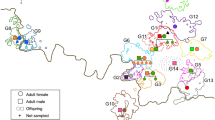Abstract
Cheirogaleids are one of the most primitive extant primate taxa in the world. Their lifestyle and mating system, therefore, have been considered to be representative for social systems in primate ancestors. Accepted models of social evolution in primates state that pair-bonding has evolved secondarily from diurnal group-living taxa and should therefore be constrained primarily to diurnal species. In contrast to these assumptions, the nocturnal fat-tailed dwarf lemur (Cheirogaleus medius) lives in permanent pairs, with obligate paternal care probably representing the evolutionary basis of pair-living. In this sociobiological field study, we analyzed the reproduction strategy of C. medius in the tropical forest of western Madagascar. In the rainy seasons from 1995 to 1999, 173 individuals of C. medius were captured and individually marked and 131 were genetically characterized through seven microsatellite loci. Additionally, 36 of these individuals were radio-tracked and observed. For 53 genotyped individuals, including 16 offspring, information about pair-bonding and family structure was known from field observations. Genetic analyses revealed that yearlings and infants living with an adult pair were in all cases sibs of the social mother. However, C. medius does not restrain from extra-pair copulations (EPCs) and a high rate of extra-pair paternity (44%) was detected. Males sired offspring with their female partners as well as with extra-pair females within the same year, indicating that males may increase their reproductive success by EPCs without necessarily running the risk of cuckoldry. Females on the other hand do not seem to run the risk of reduced paternal care, either because males cannot detect relatedness of young, or because they might even increase their inclusive fitness by raising offspring of closely related males. Since females reproduce preferentially with territory holders and no paternity could be assigned to floating males, superior genetic quality of the males might be crucial for female choice.
Similar content being viewed by others
Author information
Authors and Affiliations
Additional information
Received: 12 January 2000 / Revised: 15 August 2000 / Accepted: 26 August 2000
Rights and permissions
About this article
Cite this article
Fietz, J., Zischler, H., Schwiegk, C. et al. High rates of extra-pair young in the pair-living fat-tailed dwarf lemur, Cheirogaleus medius . Behav Ecol Sociobiol 49, 8–17 (2000). https://doi.org/10.1007/s002650000269
Issue Date:
DOI: https://doi.org/10.1007/s002650000269




